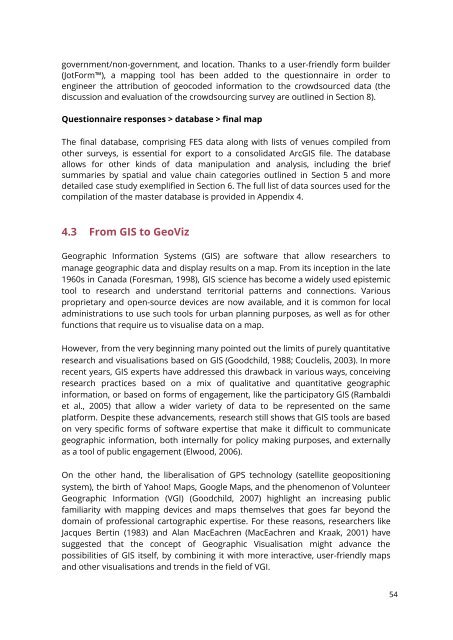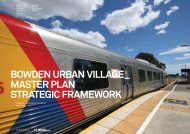MAPPING CULTURE
Mapping-Culture-Venues-and-Infrastructure-in-the-City-of-Sydney
Mapping-Culture-Venues-and-Infrastructure-in-the-City-of-Sydney
Create successful ePaper yourself
Turn your PDF publications into a flip-book with our unique Google optimized e-Paper software.
government/non-government, and location. Thanks to a user-friendly form builder<br />
(JotForm), a mapping tool has been added to the questionnaire in order to<br />
engineer the attribution of geocoded information to the crowdsourced data (the<br />
discussion and evaluation of the crowdsourcing survey are outlined in Section 8).<br />
Questionnaire responses > database > 秜ᇘ nal map<br />
The final database, comprising FES data along with lists of venues compiled from<br />
other surveys, is essential for export to a consolidated ArcGIS file. The database<br />
allows for other kinds of data manipulation and analysis, including the brief<br />
summaries by spatial and value chain categories outlined in Section 5 and more<br />
detailed case study exemplified in Section 6. The full list of data sources used for the<br />
compilation of the master database is provided in Appendix 4.<br />
4.3 From GIS to GeoViz<br />
Geographic Information Systems (GIS) are software that allow researchers to<br />
manage geographic data and display results on a map. From its inception in the late<br />
1960s in Canada (Foresman, 1998), GIS science has become a widely used epistemic<br />
tool to research and understand territorial patterns and connections. Various<br />
proprietary and open-source devices are now available, and it is common for local<br />
administrations to use such tools for urban planning purposes, as well as for other<br />
functions that require us to visualise data on a map.<br />
However, from the very beginning many pointed out the limits of purely quantitative<br />
research and visualisations based on GIS (Goodchild, 1988; Couclelis, 2003). In more<br />
recent years, GIS experts have addressed this drawback in various ways, conceiving<br />
research practices based on a mix of qualitative and quantitative geographic<br />
information, or based on forms of engagement, like the participatory GIS (Rambaldi<br />
et al., 2005) that allow a wider variety of data to be represented on the same<br />
platform. Despite these advancements, research still shows that GIS tools are based<br />
on very specific forms of software expertise that make it difficult to communicate<br />
geographic information, both internally for policy making purposes, and externally<br />
as a tool of public engagement (Elwood, 2006).<br />
On the other hand, the liberalisation of GPS technology (satellite geopositioning<br />
system), the birth of Yahoo! Maps, Google Maps, and the phenomenon of Volunteer<br />
Geographic Information (VGI) (Goodchild, 2007) highlight an increasing public<br />
familiarity with mapping devices and maps themselves that goes far beyond the<br />
domain of professional cartographic expertise. For these reasons, researchers like<br />
Jacques Bertin (1983) and Alan MacEachren (MacEachren and Kraak, 2001) have<br />
suggested that the concept of Geographic Visualisation might advance the<br />
possibilities of GIS itself, by combining it with more interactive, user-friendly maps<br />
and other visualisations and trends in the field of VGI.<br />
54



